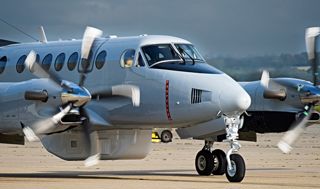
Beechcraft King Air 350
The Super King Air 200 first flew in October 1972 and differed from the original King Air with larger fuselage and a high “T” tail. First deliveries of the Super King Air 200 also occurred in 1972 as the RU-21J for the US Army. In all, over 400 Super King Airs in various versions would be ordered for the US military under the common designation of C-12 Huron. The model 200 was further developed during the mid-1980s into the Super King Air 300 series which featured better aerodynamics and more powerful engines. This has been further developed into the King Air 350 (removing the Super) with a larger wingspan and longer fuselage. The Super King Air 200 was until recently used by the RAF as its multi-engine trainer and has now been replaced by the Embraer Phenom.
Since its privatisation, QinetiQ have become a world centre of excellence for research and development. QinetiQ also operate the Empire Test Pilots School who have trained over 1,500 students in its history, their motto being “Lean to test, test to learn”. To support this, QinetiQ operate a fleet of modern training aircraft which, when not in use to train test pilots, they are used to support research and development activities.
QinetiQ will be providing a number of aircraft for static display at this year’s Air Tattoo as part of our Pushing the Boundaries theme. This will include their brand new and heavily modified King Air 350i for its debut at RAF Fairford. The aircraft features an upgraded 5-bladed prop, provision for a retractable optics turret and is fitted with a belly pod for equipment together with external payload rails. QinetiQ’s King Air will be able to stay airborne for 10 hours at a time.
Photo Credit: RIAT Volunteer
On display
| Role | Friday | Saturday | Sunday |
|---|---|---|---|
| Static | Yes | Yes | Yes |